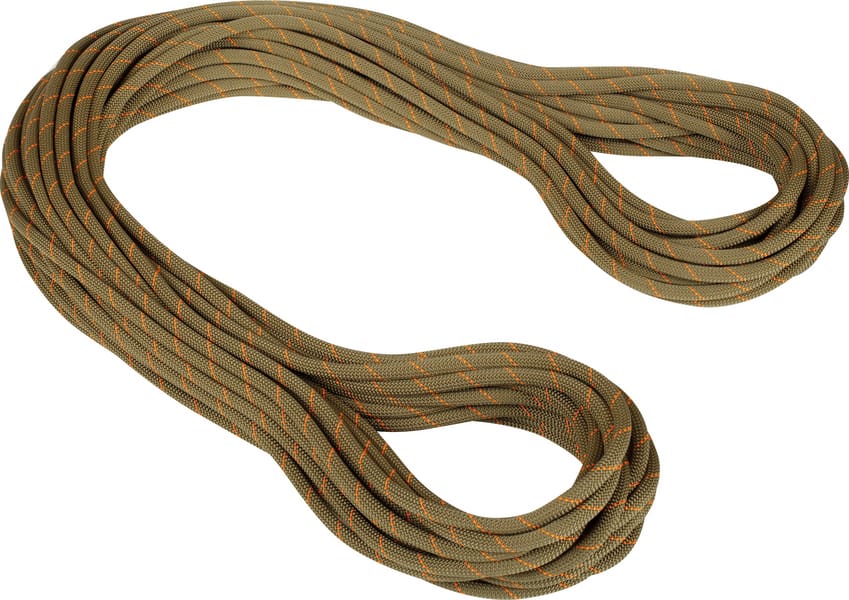Whether in the alpine area, sport climbing or in the climbing hall: there are different climbing ropes for every discipline. They all have their peculiarities and therefore their strengths and weaknesses. We illuminate the different types of rope and their purposes.
A contribution by Fabian Reichle from Bächli Bergsport
Performance ropes for sport climbing
The classic, dynamic climbing rope is suitable for sporty routes on rocks. It can be used universally and is easy to handle. Ideally, you should choose a rope length between 60 and 80 meters. The relatively large length brings some weight. To counteract this, thinner ropes are usually used than, for example, for indoor climbing; specifically with a diameter of 9 to 9,8 millimeters. In order to withstand the weather, ropes for use in sport climbing usually have an increased proportion of sheath and impregnation.
Light and thin: The OPERA GD from Beal
Shorter and thicker ropes for indoor climbing
The dynamic climbing rope is also used here. However, due to the lower climbing height in halls, it is usually somewhat shorter - typically around 50 meters. This in turn allows a slightly higher weight, the thicker ropes therefore have a diameter of 9,5 to 10 millimeters, which is good for handling. An impregnation protects against pollution, not primarily against wind and weather, but against sole abrasion and magnesium, which settles in the climbing halls.
A typical hall rope: The Mammut Gym Workhorse
Half ropes and twin ropes for alpine climbing tours
The twin rope is used in alpine terrain or on multi-pitch tours. These must always be hooked together in each intermediate backup. Twin ropes offer greater safety reserves in the event of falling rocks and sharp edges: If one of the two ropes breaks, the other can prevent the fall. An impregnated jacket and core is recommended here too. This increases longevity and security.
A typical rope for alpine tours: The Stearling Fusion Photon
Furthermore, the half rope is used for alpine climbing. Its standard requirements lie between those of single and twin ropes. It is important that two half ropes must be used together. In the event of an odd route or intermediate safety devices lying to one side, two separate rope strands can minimize friction and avoid stress on the sharp edges.
As soon as the climbing takes place in a triple rope, the rope diameter becomes relevant. The general recommendation is a minimum diameter of 8,5 millimeters. If you are traveling on glaciers, you will usually be safe with a single half rope, since the load in case of column falls is rather low. The same also applies to half ropes: an impregnated core and sheath increases safety and durability in principle.
Adam Ondra loves falling into the rope.
Climbing ropes with triple certification
The thinnest single ropes are now triple certified: they pass the standard test as single, double and twin ropes. If triple-certified ropes are used in the double strand, they offer enormous safety reserves. As a twin rope, they hold more than three to four times as much as in a single strand. They are not much heavier than classic half ropes.
Norms of climbing ropes
Ropes are life insurance and are rightly subject to strict criteria. You should know the following norms and facts.
The fall of the norm
In the event of a fall, a weight of 80 kilograms is dropped from 4,80 meters. Single ropes must be able to hold these falls at least five times. Such an extreme load will never occur in practice - for the following reason: The rope end is fixed when the standard falls, in practice there is a dynamic belay device that greatly reduces the load. The number of falls describes how often a rope can withstand this standard load.
The catch
This indicates how hard a fall is. The impact force measures the load that occurs on the safety chain in the event of a standard fall. The dynamics of the rope absorb energy. The greater the elasticity, the lower the load capacity. In the event of a fall, there is also an increased risk of coming into contact with rocky outcrops or the ground if there is strong stretching.
The impregnation
Ropes come into contact with water again and again, be it on glaciers, on ice falls or in bad weather. The critical thing is that ropes lose up to 50 percent of their strength when they are exposed to a fall from the norm. Therefore, impregnation is particularly important in high alpine use and during ice climbing.
The UIAA has been offering voluntary dry certification since 2015, creating a comparison option for the water absorption of the ropes for the first time. However, the test says nothing about the strength of wet ropes. The high requirements are only met if the rope sheath and rope core are impregnated separately.
That might interest you
About Bächli mountain sports
Bächli mountain sports is the leading Swiss specialist shop for climbing, mountaineering, expeditions, hiking, ski touring and snowshoeing. At currently 13 locations in Switzerland, Bächli Bergsport offers its customers expert advice and high-quality service. Published on LACRUX Bächli mountain sports periodically exciting contributions to the topics climbing, bouldering and mountaineering.
+ + +
Credits: Cover picture Unsplash / Brook Anderson




